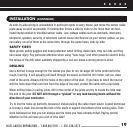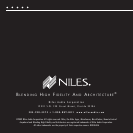
NILES AUDIO CORPORATION – 1-800-BUY-HIFI – 1-305-238-4373
19
INSTALLATION (continued)
As side-by-side wiring is unavoidable in particular spots in every house, just move the sensor cable
route away as soon as possible. If construction forces a side by side run for more than ten feet,
install metal conduit or shielded sensor cable. Low-voltage cables such as doorbells, intercoms,
telephone, speaker, security, or television cannot cause interference on your sensor cables, so you
can safely run all of them at the same time, through the same holes, side-by-side.
SAFETY FIRST!
Wear gloves, safety goggles and head protection when drilling. Avoid nails, they ruin bits and they
can cause injury. Pay particular attention when using “hole-hogs” and other powerful electric drills;
the torque of the drill when suddenly stopped by a nail can break a strong person’s wrist.
dRILLING
rough-in wiring. It will actually pull itself through the wood, so that the drill motor, not you, does
most of the work. Always drill the holes in the center of the stud. If you have to notch the stud or
drill the hole closer than one inch from the edge of the stud, protect the cable with a nail plate.
When drilling holes in ceiling joists, drill in the center of the joists and try to locate the hole near
the end of the joist. DO NOT drill through a “glulam” or any load bearing beam without the
direction of your contractor.
Try to line the holes up perfectly, because it makes pulling the cable much easier. A good technique
is to snap a chalk line across the face of the studs or against the bottom of the ceiling joists. Then
work backward so that you can always see the holes you have already drilled. Paying careful
attention to this will save you a lot of time later!


















